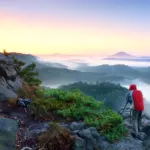Imagine a destination where **untouched wilderness** meets rich history and vibrant culture. Tasmania, an island state of Australia, and its capital Hobart provide this enchanting combination, particularly when exploring the wild landscapes surrounding the area. This article takes you through the serene beauty of Tasmania and introduces you to Hobart as the ideal gateway for adventurers seeking to experience untouched nature.
The Allure of Hobart
Hobart, nestled between the picturesque Mount Wellington and the mouth of the River Derwent, offers a unique blend of urban sophistication and natural beauty. The city’s historic charm is evident in the preserved colonial architecture and the lively waterfront, which draws visitors in with its markets, shops, and eateries. The backdrop of the majestic mountain enhances this scene, making it a picturesque start for your Tasmanian adventure.
One of Hobart’s must-visit spots is the historic **Salamanca Place**. Every Saturday, the Salamanca Market springs to life, featuring local crafts, produce, and street performances that reflect Tasmania’s vibrant culture. Another key spot is the **Museum of Old and New Art (MONA)**, known for its provocative and eclectic collection.
Gateway to Outdoor Adventures
Beyond the city limits, Hobart serves as the perfect launch pad for various outdoor activities. Hiking enthusiasts will find paradise in the nearby **Mount Wellington** with its numerous trails that offer panoramic views of the city and beyond. For the more daring, abseiling and mountain biking options are also available.
Kayaking in the Derwent River provides a different perspective of the city’s waterfront and historic sites. Additionally, the surrounding regions of Hobart are peppered with opportunities for wildlife encounters, from spotting friendly wallabies to observing rare bird species.
Exploring Tasmania’s National Parks
Tasmania boasts several national parks, each offering diverse ecosystems and unique landscapes. **Freycinet National Park** is famous for the stunning Wineglass Bay, often hailed as one of the world’s most beautiful beaches. The park’s pink granite peaks and pristine beaches create breathtaking scenery, perfect for photography, hiking, and wildlife watching.
Then there’s **Cradle Mountain-Lake St Clair National Park**, part of the Tasmanian Wilderness World Heritage Area. The **Overland Track** in this park is a bucket-list hike spanning 65 kilometers of varied terrain, from lush rainforests to alpine meadows, culminating in the awe-inspiring sight of Cradle Mountain itself.
Wildlife Wonders
Tasmania is home to an array of wildlife, much of it unique to the island. Perhaps the most iconic is the **Tasmanian devil**, a carnivorous marsupial now endangered and found only in the wild in Tasmania. Wildlife parks across the island offer the opportunity to see these creatures up close and learn about conservation efforts.
Other notable wildlife includes wombats, pademelons, and a vast range of bird species. Visit **Bonorong Wildlife Sanctuary** or **ZooDoo Zoo** near Hobart to encounter these animals and understand their habitats and behaviors.
Culinary Delights from Nature’s Bounty
No trip to Tasmania is complete without enjoying its culinary offerings. The island’s **seafood** is renowned, with fresh oysters, abalone, and scallops being highlights. The fertile soils also support a robust agricultural scene, producing high-quality ingredients for local cuisine.
Wine enthusiasts will enjoy exploring numerous **vineyards** in the Coal River and Huon Valley regions. These areas produce some of Australia’s finest cool-climate wines. Pairing a wine tasting with a visit to one of the local farm-to-table restaurants ensures a memorable gastronomic experience.
Responsible Travel and Preservation
As an island with numerous fragile ecosystems, Tasmania emphasizes the importance of **sustainable travel**. Respecting wildlife, adhering to marked trails, and supporting local conservation efforts help preserve the island’s natural beauty for future generations.
Many tour operators in Tasmania advocate for eco-friendly practices, offering tours that minimize environmental impact. Engaging with these tours not only protects the environment but provides deeper insights into Tasmania’s unique ecological heritage.
Planning Your Journey
When planning your trip to Tasmania, consider the time of year, as the island experiences four distinct seasons, each offering different opportunities for exploration. Summer (December to February) is ideal for beach activities and hiking, while winter (June to August) brings snowfall to the highlands and a different kind of serene beauty.
Regardless of the season, **Hobart’s vibrant culture** and its access to diverse landscapes make it an excellent base. From here, the wilds of Tasmania are never far, offering endless opportunities to connect with untouched nature.
In summary, Tasmania, with Hobart as your starting point, provides an unparalleled adventure for nature lovers and thrill seekers alike. Its wild landscapes, rich wildlife, and commitment to sustainability create an experience that both enriches and entertains. So pack your bags and embark on a journey to discover the wild beauty of Tasmania.



